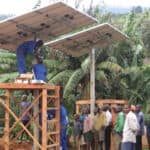Progress in Bridging the Digital Divide: Key Mobile Industry Innovations that are Bringing Internet Access to Developing Countries
In today’s hyper-connected world, many people assume that everyone can surf the web and message their friends and family online — but this is not necessarily true. More than a third of the world’s population still live in the digital dark, having never used the internet. As online technology becomes integral to day-to-day life, closing the digital divide is becoming increasingly urgent. Internet access is essential if we hope to unlock human potential and drive economic growth in underserved communities. But while mobile network operators (MNOs) have made significant strides in expanding their coverage, an unacceptable number of people — particularly those who are poor, less educated, rural, disabled and/or female — remain unconnected.
So, what exactly is the digital divide? At the most basic level, it’s the gap between people who have internet access and those who don’t — but there’s more to it than a simple lack of access. The problem has many layers and is driven by various factors, including affordability, users’ knowledge and skillsets, and access to essential facilitators of internet connectivity, such as electricity and a means of proper identification. Typically, these limitations are more apparent in least developed countries (LDCs).
Putting this in context, the International Telecommunications Union reported that in 2022, up to 17% of the population in LDCs lacked any access to fixed or mobile broadband networks, and almost two-thirds did not use the internet. Without internet, people lack access not only to entertainment and communications tools, but to information and services that can improve their quality of life. To take just one example, consider how hard it must be to get an education today without using the internet: These students face a huge disadvantage that could potentially hinder them for the rest of their lives — and the digital divide can cause similar obstacles across other common activities, from shopping to running a business.
It’s clear that this issue needs to be addressed, and we have the global capability to do so. To solve the problem, many mobile network operators in LDCs are focusing on innovations that support their customers’ ability to afford internet access, such as social tariffs, payment instalment plans, handset rentals and loans. These MNOs are also looking to extend their network coverage through infrastructural enhancements, including domestic roaming, while working with governments to expand the available mobile spectrum.
For instance, Airtel recently launched 5G in Nigeria — the third MNO in the country to do so — a promising sign of the growing investment in mobile access in Africa, and another encouraging step in the global 5G rollout. Meanwhile, according to Ericsson’s June Mobility Report, global 4G subscriptions hit 5.2 billion in the first quarter of 2023, and global 5G subscriptions are predicted to hit around 4.6 billion by the end of 2028, making it the leading mobile access technology.
MNOs and other stakeholders are achieving these goals through a number of tactics, including co-creation, open standards for radio access networks, technological access to more radio bandwidth, and regulatory support. Let’s take a closer look at these areas.
Collaborating to Bridge the Digital Divide
Collaboration is an essential element of infrastructure creation and the development of digital skills. Providing a telecoms infrastructure and creating affordable high-speed connectivity is expensive, particularly in sparsely populated rural areas. Focussing on innovation and co-creation by investing in shared infrastructure (where MNOs team up to reduce infrastructure ownership costs and deliver wider access) can offer a scalable and affordable solution.
This partnership model is becoming well-established in many regions, as cooperation between public, private and community partners provides access to technology and boosts the skills of everyone involved. To take one example, the UNDP’s Istanbul International Centre for Private Sector in Development and the UN Technology Bank for the Least Developed Countries jointly launched the Frontier Tech Leaders Programme earlier this year. The programme aims to address the digital divide by upskilling young tech specialists in LDCs and equipping them to combat local challenges that are limiting connectivity.
Open Standards for Radio Access Networks
In the broader tech sector, open standards ensure that various digital systems work together seamlessly, allowing for greater compatibility and interoperability between different technologies. In the telecom industry in LDCs, a limited choice of technology providers and a lack of flexibility has made it challenging for MNOs to manage their networks nimbly. However, that’s changing as these operators embrace open standards, and Open Radio Access Networks (Open RAN) provide one example of this shift. The shift to Open RAN involves disaggregating network hardware and software, which is traditionally bound together and supplied by a single telecom equipment supplier. Interfaces between different parts of the radio access network — the component of a wireless telecommunications system that connects individual devices to other parts of the network through a radio link — are standardized in an open network, facilitating a greater diversity of equipment vendors within the supply chain.
An Open RAN reduces the costs of deploying and operating mobile networks, which makes this approach well suited for rural and remote areas. However, mobile operators in advanced markets are also looking at the technology to enable innovation and increased flexibility when upgrading networks.
Leading MNOs are already making commitments to upgrade their networks through this technology. For instance, Vodafone aims to have 30% of its European network in Open RAN by 2030. Momentum is also building in regions such as Africa: In 2022, a range of MNOs, including the African MTN Group, signed an Open RAN Memorandum of Understanding to accelerate the adoption of this technology. In that partnership, MTN and mobile telecom industry business-to-business service provider Rakuten Symphony are working with Accenture and Tech Mahindra on Open RAN proof-of-concept trials in South Africa, Nigeria and Liberia, drawing on Rakuten’s network automation and orchestration solutions.
Boosting Internet Speed Through a Broader Radio Spectrum
Mobile network operators are also developing technology to harness a broader radio spectrum to provide faster download speeds and data transfers. One such innovation is millimeter wave technology, which uses very high frequency radio waves (30 GHz to 300 GHz) to deliver fibre optic-like speeds over the air. In urban and suburban use cases, this technology allows unparalleled mobile broadband speeds to be delivered to homes and businesses at a fraction of the cost of fibre optic cables. It has the potential to enable similar applications in remote or less developed regions where there is a lack of network infrastructure, such as fibre optic cables.
Working with Pivotal Commware in South Africa, MTN recently concluded a 5G millimeter wave field trial which aimed to cost-effectively improve broadband service coverage and lower the price point for local network users. This innovation offers an exciting technological opportunity in developing regions, with the potential to connect communities and close the digital divide.
Regulatory Reform to Expand Internet Access
However, despite these promising developments, technology and ambition alone aren’t going to expand internet access to underserved communities. Policy reform that reduces the digital divide is also paramount if we hope to achieve meaningful change and ensure connectivity for all. New regulatory frameworks must set clear objectives to accurately measure the availability and quality of network coverage and penetration, while establishing clear goals to make further improvements.
In a sector with high costs and many barriers to entry, such as limited spectrum availability, it’s also paramount that national digital strategies encourage competition, promote investment and support network infrastructure deployment. Open networks are a pivotal step in this transition.
Progress Toward a Better-Connected Future
In today’s world, access to the internet and digital technologies is absolutely vital for education, employment, healthcare, and social and political participation. A lack of access to these resources can have significant and long-lasting consequences, especially for marginalized communities.
Fortunately, despite the complexities of bridging the digital divide, progress is being made — and the social and economic benefits are huge. For instance, 4G will account for more than half of new mobile subscriptions in sub-Saharan Africa by 2028, with massive implications for the region’s overall development.
But there is still work to do, so mobile network operators must not take their foot off the gas. Closing the access gap benefits and enables economic development by increasing productivity, employment, innovation and GDP growth, and it can support LDCs in developing global competitiveness. This goal must be kept front of mind as we move into an increasingly high-tech future, working to mobilize the vast potential of digital technologies to achieve a prosperous and inclusive society for all.
Andy McLean is Corporate VP of Communications and Cloud at Analog Devices.
Photo courtesy of World Bank Photo Collection.
- Categories
- Technology, Telecommunications



